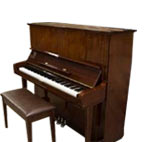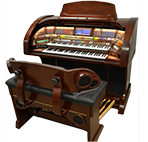 Although he lived only a short time, Giovanni Battista Pergolesi composed some of the eighteenth century’s most beloved works, among them the sacred duet Stabat Mater and the comic intermezzo La serva padrona. In fact, Pergolesi was so much admired that after his death, unscrupulous musicians saw his name as a ticket to success, forging Pergolesi’s name to hundreds of works that the composer never touched. As a result, scholars are still trying to decide what Pergolesi actually wrote.
Although he lived only a short time, Giovanni Battista Pergolesi composed some of the eighteenth century’s most beloved works, among them the sacred duet Stabat Mater and the comic intermezzo La serva padrona. In fact, Pergolesi was so much admired that after his death, unscrupulous musicians saw his name as a ticket to success, forging Pergolesi’s name to hundreds of works that the composer never touched. As a result, scholars are still trying to decide what Pergolesi actually wrote.
Birth and Education
Pergolesi was born in the Italian town of Iesi on January 4,1710. He was occasionally referred to by the town’s name or by the family’s original surname of Draghi. “Pergolesi” comes from the town of Pergola, where the family lived before moving toIesi.
Pergolesi’s father, Francesco Andrea Draghi-Pergolesi, surveyed the lands of noblemen in and around Iesi. One of these noblemen became Pergolesi’s godfather. Pergolesi had two brothers and one sister, but all died very young. Pergolesi himself was apparently sickly his entire life and had a persistent limp.
Much of what is known about Pergolesi’s childhood comes from much later accounts and is not necessarily to be relied on. These sources say that he was trained by the maestro di cappella at Iesi, Francesco Santi, and the head of the city’s music. Not long thereafter, a noble supporter, Marquis Cardolo Maria Pianetti, recognized his talent and sent him to study at one of the best-known conservatories in Italy, the Conservatorio dei Poveri di Gesù Cristo in Naples. This happened when Pergolesi was between the ages of ten and fifteen, but the exact dates are not certain. At the conservatory, Pergolesi’s teachers included Gaetano Greco, Leonardo Vinci, and Francesco Durante. In addition to composition, Pergolesi excelled at singing and violin.
Early Successes in Naples
Just before he left the conservatory in the late summer of 1731, Pergolesi had a religiousopera premiered at the monastery of Sant’Agnello Maggiore. The work was successful enough to be performed after Pergolesi’s death as well.
After leaving school, Pergolesi got his first commission for a non-sacred opera, but the resulting work, Salustia, was not a success when it premiered in January 1732. Theprimo uomo (leading man), Nicolini, had died just before the premiere, and other roles had had to be altered in great haste. Nevertheless, Pergolesi’s talent was recognized by Prince Ferdinando Colonna Stigliano, equerry to Count von Harrach, Viceroy of Naples. The nobleman appointed Pergolesi his maestro di cappella in 1732. Soon thereafter, Pergolesi had his first great success with the comic opera Lo frate ‘nnamorato, whose words were in the Neapolitan dialect. It was supposedly popular for the next quarter of a century.
After the earthquakes that shook Naples in 1731 and 1732, the city decided to make St. Emidius, patron saint of protection against earthquakes, its own patron saint as well. Several special festivals were proclaimed in Emidius’s honor, and Pergolesi wrote music for several such occasions.
Because of the earthquakes, the Neapolitan theaters were closed for most of 1733. Pergolesi was commissioned to write an opera for one of the first occasions upon which operas were again permitted, Empress Elisabeth Christine’s birthday on August 28,1733. The resulting opera, Il prigionero superbo, was performed on September 5,1733.
As was the custom at that time in Naples, the acts of the main opera were interspersed with those of a smaller comic opera called an intermezzo. This particular intermezzo, La serva padrona, was to raise Pergolesi’s reputation to great heights. After Pergolesi’s death, it also caused great controversy when performed in France.
Between Rome and Naples
In Febraury 1734, Pergolesi was appointed successor to the maestro di cappella of Naples. Just a month later, because the Spanish had retaken Naples from the Austrians, the Prince of Stigliano (Pergolesi’s patron) fled the city for Rome.
Pergolesi seems to have accompanied the Prince. At any rate, Pergolesi’s Mass in F was performed in Rome in the church of San Lorenzo in Lucina on May 16, 1734. This performance was with the support of the Duke of Maddaloni, who was a distant relative of the Prince of Stigliano. According to members of the audience, the church was so overcrowded that the floor almost collapsed.
Soon thereafter, Pergolesi became the Duke of Maddaloni’s maestro di cappella and returned to Naples in June 1734. The Duke was a good friend of King Charles, the ruler of Naples, and Pergolesi was asked to write an opera for the king’s mother’s birthday on October 25, 1734. The resulting opera, Adriano in Siria, is considered perhaps Pergolesi’s greatest serious opera, but it was also the last that he wrote for Naples. A letter written by the impresario of the Teatro San Bartolomeo in Naples says that Pergolesi was no longer popular with audiences there, although connoisseurs still esteemed the composer highly.
Roman audiences were still interested in Pergolesi, however. In 1735, he wroteL’olimpiade for the Teatro Tordinona in Rome. Unfortunately, the singers were mediocre, and someone supposedly threw an orange at Pergolesi during one of the performances, hitting him on the head. Later in the century, however, L’olimpiadebecame much more popular.
Final Illness
Pergolesi became ill in the summer of 1735 but continued to compose, producing the comic opera Il Flaminio for Naples. It proved much more successful than his recent serious operas had been. According to the libretto, Pergolesi was at this time organist for the royal chapel.
The next year, his illness led Pergolesi to retreat to a monastery in Pozzuoli. Upon leaving Naples, he gave his belongings to his aunt and former housekeeper, Cecilia Giorgi. Even as Pergolesi’s health declined, however, he wrote two of his best-known works, the Stabat mater and the Salve regina. These were both intended for the use of the monks with whom he was staying. The composer died on March 16, 1736, and was buried in a mass grave in Pozzuoli.










